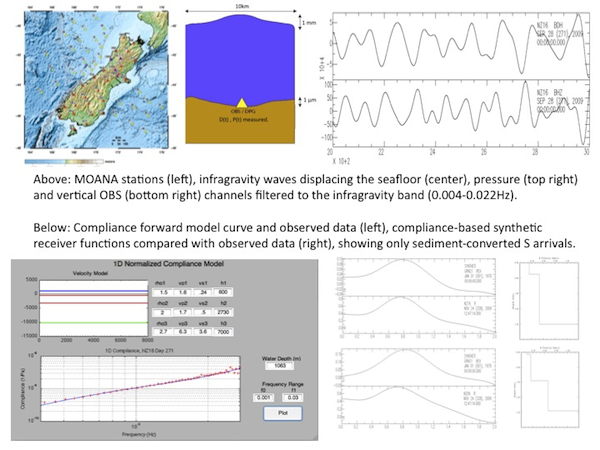2012 IRIS Workshop
Mode-Converted Shear Waves and Seafloor Compliance Measurements off the South Island of New Zealand
Justin S. Ball: CIRES and the Department of Geological Sciences, University of Colorado, Boulder, Anne F. Sheehan: CIRES and the Department of Geological Sciences, University of Colorado, Boulder
Seafloor compliance schematic, data and its application to characterizing sediment velocity structure at an OBS site.

Full-resolution graphics file in original format: 0121.jpg
The Marine Observations of Anisotropy Near Aotearoa (MOANA) experiment deployed 30 broadband ocean bottom seismometers (OBS) with collocated differential pressure gauges (DPGs) off the South Island of New Zealand in 2009-2010. The goal of the MOANA experiment is to employ seismic anisotropy measurements to characterize the mantle rheology beneath New Zealand. Teleseismic techniques for resolving anisotropy using body waves are difficult to implement at OBS sites due largely to the effects of low-velocity sediments and water layer reverberations. Removal of sediment effects from teleseismic data typically requires accurate characterization of sediment layer shear velocities and thicknesses. Ocean surface gravity wave energy at sufficiently long periods can propagate to the seafloor producing a time-varying pressure load. The transfer function between applied pressure and resulting displacement fields at the seafloor is known as the seafloor compliance and depends strongly on the shear wave velocity structure beneath the measurement site. Thus seafloor compliance models can constrain the thickness-velocity tradeoff for the sedimentary column contribution to mode-converted shear wave arrival times. Seafloor compliance curves were calculated from MOANA DPG pressure and OBS vertical component acceleration power spectra at periods between 50-250s and normalized by the coherence between pressure and acceleration signals. The resulting compliance values range from 10^-10 to 10^-8 Pa^-1 and are sensitive to changes in shear modulus at depths that increase with forcing period. 1D forward velocity models with a depth range of 70-3000m are used to calculate synthetic compliance curves, and the best-fitting compliance model for each station is used to compute synthetic sedimentary layer receiver functions. The compliance-constrained receiver functions are compared with the observed data to isolate sediment-converted shear waves from the deeper signals of interest. Preliminar
Acknoweldgements: The authors wish to thank Wayne Crawford, Eleanor Willoughby, Spahr Webb and John Collins for graciously providing their code and guidance. Software from the IRIS consortium, GMT project, Robert Herrman and Charles Ammon were instrumental in this work. Support was provided by NSF EAR-0409835.
Keywords: seafloor_compliance, receiver_function
